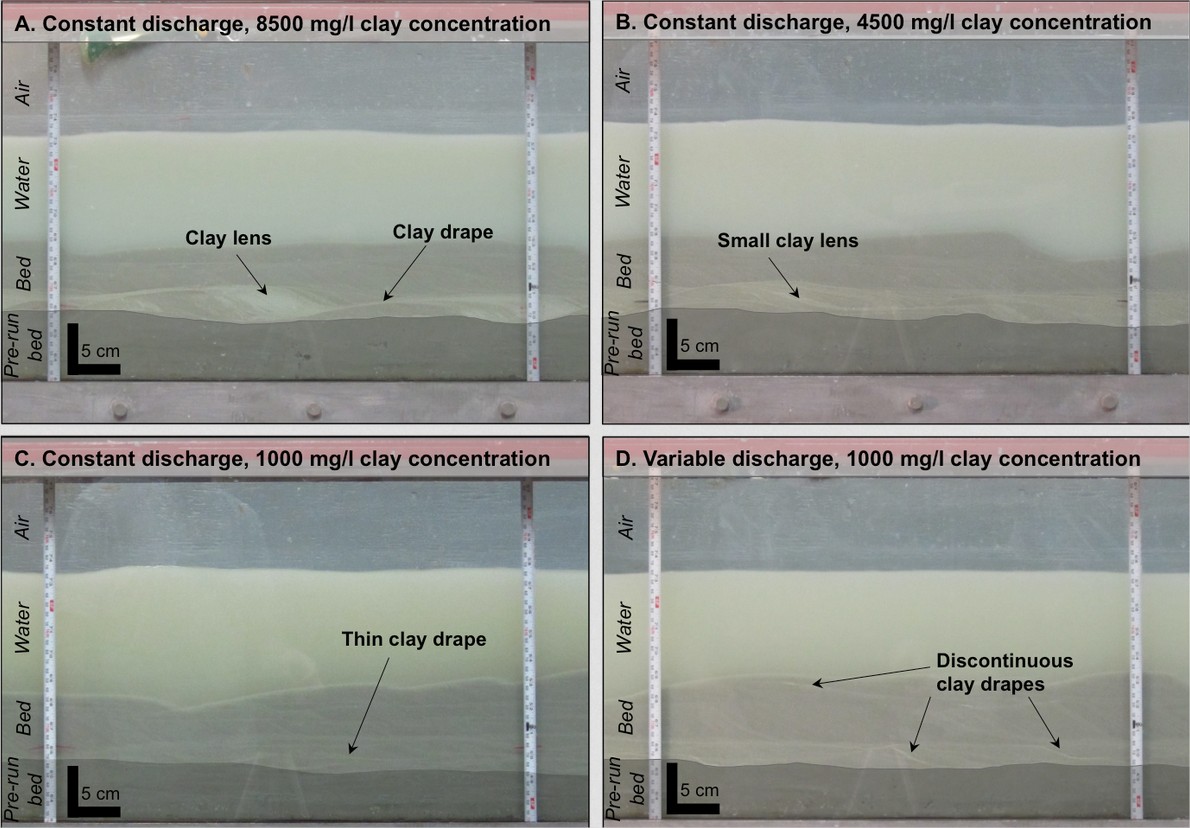Reports: DNI851950-DNI8: Fine-Sediment Storage and Bypass in Sandy Fluvial Systems
Elizabeth Hajek, Pennsylvania State University
Sandy-fluvial deposits are important hydrocarbon and water reservoirs. However, they can be difficult to predict and efficiently produce due to particle-size heterogeneities ranging from pore to basin scale. Fine sediment (silt and clay) is transported as suspended load and is either bypassed through a river as wash load or is deposited and stored in the channel bed or on the floodplain. Clay accumulations in subsurface-channel deposits can cause porosity and permeability reduction at the pore scale and act as baffles and barriers that compartmentalize flow at reservoir scales. Grain-size heterogeneity within fluvial deposits may record paleo-flow variability and/or paleo-sediment supply, but without improved understanding of the conditions under which clay can accumulate in sandy river beds, it is difficult to uniquely interpret these deposits.
In order to better understand the processes controlling when and where fine sediment accumulates in sandy river beds, we conducted a series of physical experiments to test if there is a relationship between supplied-clay concentration and the amount of clay preserved in aeriver bed under constant and variable-discharge conditions. In a 15.5 m feed-style flume, water discharge of 0.21 m3/s and sand supply of 15 g/s were used to aggrade a sandy bed 6.5 cm over the course of 4 hours. In three constant-discharge experiments, clay was added in concentrations of 1000 mg/l, 4000 mg/l and 8500 mg/l. An additional experiment with 1000 mg/l clay concentration was conducted with variable-water discharge, where discharge was slowed to a stop every hour of run time and clay allowed to settle for one hour three times and once overnight. After each experiment, samples were collected from the dry bed and analyzed for clay content and clay deposits observable in the bed were mapped in order to determine the nature and distribution of clay accumulations in the bed.
Results demonstrate that under constant discharge conditions, clay can accumulate in the bed and that the amount of clay retained in the bed is related to the amount of clay supplied to the flume. In sediment deposited with a low clay concentration, little to no clay accumulated in the bed, while under high clay concentration, as much as 5-10 % of the bed is comprised of clay rich lenses and 40 percent of the bed is likely to have clay intercalated in pore space. Additionally, clay accumulations that form under constant-discharge conditions have a unique character and may be differentiable from those formed under variable-discharge conditions. Clay accumulations deposited under variable flow conditions appear as discontinuous clay drapes, while under constant flow conditions they appear as continuous clay drapes, clay rich lenses, and as intercalated clay. In all experiments, clay retention was highest in the main aggradational phase of the runs, with markedly less clay preserved during bypass. These results suggest the nature of clay accumulations in sandy channel deposits may be useful for reconstructing paleo-discharge conditions, and that subsurface reservoir quality may be predictable if these conditions can be constrained.
Ongoing work addresses how these results may be applied to ancient field settings in an effort to improve reservoir quality interpretations and predictions.
This ACS PRF grant has facilitated career development for the PI, graduate student, and also undergraduate students involved in the project. Student Nate Wysocki is preparing to graduate in December 2015. As part of his preparation for this research, he has connected with oil companies and was able to complete an internship and will be starting a job with Chevron after he defends his thesis. This grant enabled him to pursue a challenging independent research project while simultaneously completing coursework designed to prepare him for a career in industry. This work represents a significant extension of PI Hajek's experience, and the preliminary results are promising and should provide enough material to develop a larger NSF proposal to extend these research efforts. An additional benefit of this project was the involvement of undergraduate Geology students from a local college Macalester College in St. Paul, MN. Students in the Fall 2013 Sedimentology and Stratigraphy class helped pour 50-pound bags of clay into the flume every 10 or 15 minutes over the course of a 6-hour experimental run. This provided essential support for the completion of the experiments, and provided a unique hands-on opportunity for geology students at undergraduate-only institution to see how graduate-level research is conducted. Several students who participated in this experience have begun to make plans for pursuing advanced geoscience degrees when they graduate.
Figure: Experimental deposits showing clay accumulations in sandy river beds formed under constant (A, B, and C), and variable (D) discharge conditions. The variable geometry and distribution of these deposits between each experimeint suggests that understanding paleo-flow conditions for ancient fluvial deposits will be useful for predicting reservoir quality in hydrocarbon-bearing subsurface river deposits. <p"ine-height: 200%;"="200%;"">












